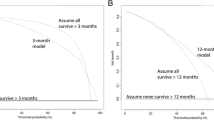Abstract
Background and Purpose:
For practitioners, the question arises how their own patient population differs from that used in large-scale analyses resulting in new scores and nomograms and whether such tools actually are valid at a local level and thus can be implemented. A recent article proposed an easy-to-use method for the in-clinic validation of new prediction tools with a limited number of patients, a so-called sequential testing approach. The present study evaluates this approach in scores related to radiation oncology.
Material and Methods:
Three different scores were used, each predicting short overall survival after palliative radiotherapy (bone metastases, brain metastases, metastatic spinal cord compression). For each scenario, a limited number of consecutive patients entered the sequential testing approach (Table 1). The positive predictive value (PPV) was used for validation of the respective score and it was required that the PPV exceeded 80%.
Results:
For two scores, validity in the own local patient population could be confirmed after entering 13 and 17 patients, respectively (Figures 1 and 3). For the third score, no decision could be reached even after increasing the sample size to 30 (Figure 2).
Conclusion:
In-clinic validation of new predictive tools with sequential testing approach should be preferred over uncritical adoption of tools which provide no significant benefit to local patient populations. Often the necessary number of patients can be reached within reasonable time frames even in small oncology practices. In addition, validation is performed continuously as the data are collected.
Zusammenfassung
Hintergrund und Ziel:
Klinisch tätige Onkologen müssen sich angesichts der Neuentwicklung zahlreicher Scores und Nomogramme fragen, ob diese in ihrer eigenen Patientenpopulation valide sind und eingeführt werden sollen. In einem kürzlich publizierten Artikel wurde eine einfache Methode vorgestellt, die mit einer begrenzten Zahl von Patienten eine lokale Validierung erlaubt. Dieses sequentielle Testverfahren wird hier für radioonkologisch relevante Scores erprobt.
Material und Methodik:
Als Beispiele dienten drei Scores, die ein kurzes Überleben nach palliativer Strahlentherapie von Knochen- und Hirnmetastasen bzw. metastatischer Rückenmarkkompression vorhersagen. Es wurden jeweils die ersten konsekutiven Patienten mit diesen Diagnosen sequentiell getestet (Tabelle 1). Zur Validierung wurde der positive prädiktive Wert eines Scores benutzt. Letzterer sollte 80% übersteigen.
Ergebnisse:
Für zwei Scores ließ sich die Validität im eigenen Patientengut nach 13 bzw. 17 Patienten bestätigen (Abbildungen 1 und 3). Für den dritten Score konnte selbst nach 30 Patienten keine Entscheidung getroffen werden (Abbildung 2).
Schlussfolgerung:
Die eigene Überprüfung neuer prädiktiver Modelle mittels sequentieller Evaluierung sollte der unkritischen Einführung vorgezogen werden, da nicht alle Scores auf alle Patientenpopulationen anwendbar sind. Die erforderlichen Patientenzahlen können oft auch in kleineren Praxen innerhalb überschaubarer Zeiträume erreicht werden. Von Vorteil ist auch, dass die Validierung kontinuierlich erfolgt, während neue Patienten behandelt und eingeschlossen werden.
Similar content being viewed by others
References
Beam CA, Gao W, Macias V, et al. Sequential testing approach as an efficient and easier alternative for the validation of new predictive technologies in the clinic. J Clin Oncol 2009;27:1087–90.
Dellas K, Bache M, Pigorsch SU, et al. Prognostic impact of HIF-1α expression in patients with definitive radiotherapy for cervical cancer. Strahlenther Onkol 2008;184:169–74.
Mizumoto M, Harada H, Asakura H, et al. Prognostic factors and a scoring system for survival after radiotherapy for metastases to the spinal column: a review of 544 patients at Shizuoka Cancer Center Hospital. Cancer 2008;113:2816–22.
Nieder C. Two new prognostic indices for brain metastases — where do we go from here? Strahlenther Onkol 2008;184:488–9.
Piroth MD, Gagel B, Pinkawa M, et al. Postoperative radiotherapy of glioblastoma multiforme. Analysis and critical assessment of different treatment strategies and predictive factors. Strahlenther Onkol 2007;183:695–702.
Rades D, Dunst J, Schild SE. A new scoring system to predicting the survival of patients treated with whole-brain radiotherapy for brain metastases. Strahlenther Onkol 2008;184:251–5.
Rades D, Dunst J, Schild SE. The first score predicting overall survival in patients with metastatic spinal cord compression. Cancer 2008;112:157–61.
Wald A. Sequential analysis. New York: Wiley, 1947.
Yoshioka Y, Suzuki O, Kobayashi K, et al. External-beam radiotherapy for clinically localized prostate cancer in Osaka, Japan, 1995–2006. Time trends, outcome, and risk stratification. Strahlenther Onkol 2009;185:446–52.
Author information
Authors and Affiliations
Corresponding author
Rights and permissions
About this article
Cite this article
Nieder, C., Haukland, E., Pawinski, A. et al. Validation of New Prognostic and Predictive Scores by Sequential Testing Approach. Strahlenther Onkol 186, 169–173 (2010). https://doi.org/10.1007/s00066-010-2095-4
Received:
Accepted:
Published:
Issue Date:
DOI: https://doi.org/10.1007/s00066-010-2095-4




